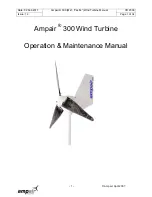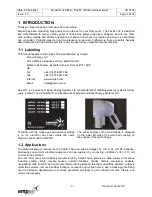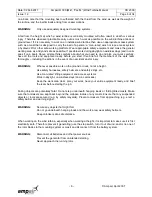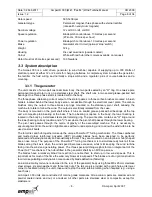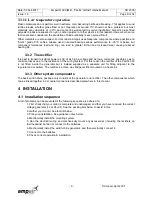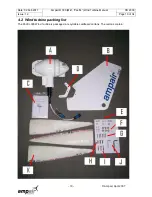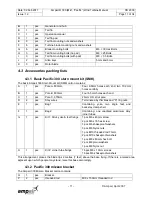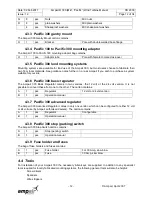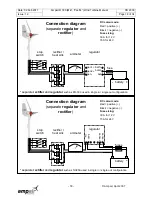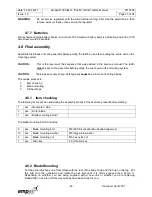
Date: 02 Feb 2011
Ampair ® 300 (Mk1, “Pacific”) Wind Turbine Manual
CD 2300
Issue: 1.2
Page 8 of 34
- 8 -
© Ampair, April 2007
Rotor speed
500-1400 rpm
Generator type
Permanent magnet, three phase with external rectifier
(rare earth neodymium magnets)
Nominal voltage
12 volt DC or 24 volt DC
Speed regulation
Blade pitch control above 13 metres per second
(27 knots, 30 miles per hour)
Power regulation
Blade pitch control above 13 metres per second
Brake
Generator short circuit (optional 'stop' switch)
Weight
12 kg
Housing
Die cast aluminium (powder coated)
Colour
White with red hub (other colours available on request)
Rotor thrust (at 20 metres per second)
160 Newtons
3.3 System description
The Ampair 300 is a wind driven generator (a wind turbine) capable of supplying up to 300 Watts of
electrical power at either 12 or 24 volts for charging batteries. A complete system includes the generator,
the rectifier, the field wiring, and normally a stop switch and a regulator, plus of course batteries and a
mounting.
3.3.1 The generator
The unit consists of a two part cast aluminium body, the two parts sealed by an "O" ring. One twelve pole
permanent magnet rotor runs on a stainless steel shaft. The shaft runs in two sealed grease-packed ball
bearings. One three phase stator is located within the body.
The three phase alternating current output of the stator passes to three carbon brushes mounted in brush
holders located behind the lower body section, accessible through the electrical cover plate. The carbon
brushes carry the output to three brass slip rings mounted on the stationary pivot shaft, allowing the
machine to rotate to follow the wind. The output is electrically isolated from the case.
The body is mounted on the pivot shaft where it runs on sealed grease packed ball bearings at the top
and a composite plain bearing at the base. The top bearing is captive in the body; the lower bearing is
located in the body by a stainless steel spiral retaining ring. The pivot section contains an "O" ring around
the lower bearing to body junction and a "V" seal where the pivot shaft passes through the lower bearing.
The pivot axis passes through the centre of gravity of the assembled machine. This is necessary to
ensure alignment into the wind in light breezes without undue spinning, and to allow the wind turbine to be
used on small boats.
The ro
tor disc and hub together make up the unique PowerFurl™ furling mechanism. The three
cambered
and twisted glass reinforced polyester (GRP) moulded blades have been designed to be perfectly
balanced and aerodynamically and acoustically efficient. They are mounted on an aluminium hub (shaped
like a nose cone).
The purpose of the PowerFurl™ furling mechanism is to simultaneously twist all three
blades along their axis when the wind speed becomes excessive, whilst still keeping the wind turbine
facing into the wind and generating power. The three special pitching weights form an integral part of the
PowerFurl™ mechanism.
The hub is fitted to the generator shaft by an M10 cap screw.
The blades have a relatively broad root section to enable them to start up in low wind speeds. This is
important as for much of the time the wind only blows at low speeds. The blades are of a rigid construction
to minimise pulsating aerodynamic noise caused by blade deflection (fluttering)
An aluminium alloy tail vane is clamped to the rear of the generator body using three M8 x 25mm stainless
steel screws, six plain washers and three lock nuts. The tail vane is provided with a grab hole at its lower
corner to facilitate turning the unit cross-wind to stop the wind turbine rotating when required (e.g. using a
boat hook).
All Ampair 300 units are constructed of marine grade materials. All aluminium parts are alacromed and
powder coated inside and out, or anodised. All other parts are stainless steel or composite, except for
elastomers.

